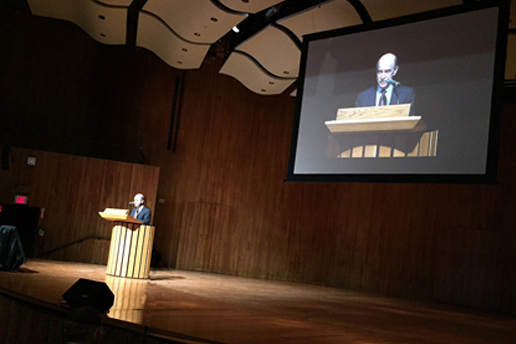
Leading CEOs, academics and entrepreneurs in global energy converged on MIT this past weekend for the tenth annual MIT Energy Conference, which explored “Global Energy Shifts.” Panels delved into four key areas: power and renewables, fossil fuels, global collaboration, and sustainable development.
Key speakers over the two day gathering included Thomas Siebel, Founder and CEO of C3 Energy, Bill Colton, Vice President of Corporate Strategic Planning at ExxonMobil Corporation, Ahmad Chatila, President and CEO of SunEdison, Dirk Smit, Chief Scientist at Shell Global, David Danielson, Assistant Secretary of Energy at the DOE, and William A. Von Hoene, Jr., Chief Strategic Officer at Exelon Group, among others.
MIT Energy Initiative (MITEI) director Robert Armstrong delivered opening remarks to a packed auditorium. Armstrong lauded the conference’s ability to consistently touch upon the most pressing energy issues of our time, and to foster an atmosphere conducive to solving challenges in a creative and efficient way.
“There are five topics in particular that are going to be of importance in the energy world in the near future,” said Armstrong. “Solar is the first.”
“Though solar is admittedly difficult, because it’s a resource that’s not concentrated in one place, it also is an easily and cheaply manufactured technology, which will help widen its reach.”
Armstrong next pointed to both energy storage and then the grid. “Energy storage is essential for large scale incorporation of renewables on the grid. The grid’s size, resiliency, reliability, security and adaptability need to be taken into account if the full potential of emerging energy technologies is going to be achieved.”
MITEI’s director also urged his audience to pay attention to emerging technologies in two areas: nuclear energy and carbon capture and sequestration, or CCS.
“In a truly balanced energy ecosystem, nuclear needs to be part of the solution. Leaps forward in affordable and predictable nuclear will change our energy landscape for the better.”
Armstrong has similarly high hopes for carbon capture and sequestration. Citing the projection that global energy demand will double by midcentury, he observed that fossil fuels will have to be a part of that equation.
“The need to remove carbon from the atmosphere is very real, and CCS technology will play a critical role in solving this problem.”
Armstrong’s vision for the MIT Energy Initiative within the energy landscape is clear – “The MIT Energy Initiative has at its heart – just as the MIT Energy Club does – a goal of bringing all the talents of MIT together to bear on these very real challenges.”
The rest of the conference’s panels kept this solution-oriented spirit alive.
At an afternoon panel on fossil fuels called “Unconventional Resources: Present to Future, U.S. to Global,” Christopher Knittel, the William Barton Rogers Professor of Energy Economics at MIT Sloan and a MITEI-affiliated researcher, led a group of experts in a discussion of the future of shale gas drilling.
Another panel approached the issue of how to promote a different kind of unconventional resource: renewable energy. In the session “Securing the Future of Clean Energy Through a Stronger Transmission Backbone,” panelists from across the clean energy sector approached the issue of how to better integrate renewables into the grid.
In all, the sold-out conference featured over fifty speakers participating in over fifteen panels and keynotes tackling key global energy issues.
For more information about the day, visit the MIT Energy Conference’s website.